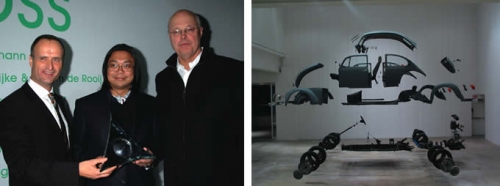From Matthew Barney to Rirkrit Tiravanija
Corporate support for the arts takes all manner of forms, including the collection of works, the sponsorship of exhibitions and residence programs, and the establishment of prizes. But just why and how do corporates make such an effort to prop up the arts? In this series we consider the relationship between the corporate sector and the arts by looking at some specific examples.
Research/text: ART iT
German-based global fashion company Hugo Boss has been supporting the art scene now for over a decade. While the company is also a supporter of other cultural activities such as the Salzburg Music Festival, art fans worldwide associate the Hugo Boss name first and foremost with its championing of contemporary art. In Japan for example, the company’s role as an art sponsor was obvious for all to see at the Olafur Eliasson exhibition staged at the Hara Museum of Contemporary Art commencing in the autumn of 2005.
A pioneering and authoritative award
Among its many cultural initiatives, it is the Hugo Boss Prize to which Hugo Boss devotes the greatest time and resources. A glance at the list of past nominees reveals a glittering pantheon of contemporary artists. The first winner, in 1996, was Matthew Barney, widely known for his Cremaster series. The last winner (2004) was leading Thai artist Rirkrit Tiravanija. Other names include Douglas Gordon, who with Philippe Parreno produced a ’21st century portrait’ in photographs of the soccer hero Zidane. If all the nominated artists are included, to use a soccer analogy, one finds superstars of World Cup class from countries all over the world.
Judging for the Hugo Boss Prize takes place biennially, via deliberations by a panel of six curators, art critics, and other individuals of international standing in the art world, including the director of the Guggenheim Museum in New York. Six artists or artist groups are nominated each time, and one winner selected. Winners are awarded prize money of $50,000 (approx. six million yen), and after receiving their prize, stage a solo show at the Guggenheim.
Looking back, the lineup of past winners reads like an art textbook written by an art historian of the future. It must be said choosing Matthew Barney ten years ago showed impressive foresight. With judges of such prescience, artists destined to be future leaders of the art world will continue to be chosen, and continue to work after winning, in the process further enhancing the authority of the prize. A positive cycle has been generated between prize and prizewinners, something that can also be said for the Turner Prize in Britain.
To be pioneering also means to be risky. To date however, where the Hugo Boss Prize has gambled it has consistently won, and it looks to be consolidating its foothold in the art world, or in fact, has probably already done so.
Boosting the Hugo Boss brand image
According to Dr. Hjordis Kettenbach, Head of Arts Sponsorship at Hugo Boss head office, “The Hugo Boss Prize is conferred upon artists whose work represents a significant contribution to contemporary visual art. The degree of fame achieved by an artist to date is not relevant for the selection process. The Prize is an integral component of our arts program and, as such, demonstrates the continuity of our commitment to this field. The Hugo Boss Prize has become one of the most significant awards in the contemporary art world.”
She also indicates that a positive cycle has emerged not only between prize and prizewinners, but also between the business, that is Hugo Boss, and the consumer.
“Public perceptions mirror that estimation: this image then also reflects favorably on the Hugo Boss brand world.”
The existence of the prize has also had a positive effect not only outside the company, but inside as well.
“The fact that Hugo Boss honors contemporary artists has become firmly established in the minds of our employees. At the same time, there has been a growing understanding of modern art among our staff: an entire range of internal programs has been initiated by the Hugo Boss Group with the aim of enhancing its employees’ appreciation – and enjoyment – of art.
For some time now much has been made of the importance of CSR (Corporate Social Responsibility). There are various potential ways for a company to make a contribution to society, but for artists and the art world, and particularly for art lovers, corporate support for art is especially heartening, and always welcome. This year’s winner of the Hugo Boss Prize will be announced in November.
 Left: Dr. Bruno Salzer (CEO Hugo Boss), Rirkrit Tiravanija (2004 Hugo Boss Prize winner)
Left: Dr. Bruno Salzer (CEO Hugo Boss), Rirkrit Tiravanija (2004 Hugo Boss Prize winner) and Thomas Krens (Director Solomon R. Guggenheim Foundation)
Right: Damian Ortega, Cosmic Thing, 2002
Stainless steel wire, 1983 Volkswagen Beetle, and Plexiglas
The Museum of Contemporary Art, Los Angeles
Purchased with funds provided by Eugenio Lopez and the Jumex Fund for Contemporary Latin American Art
Photo courtesy the artist and kurimanzutto, Mexico City
 Left: Jennifer Allora & Guillermo Calzadilla, 10 minute transmission, 1998-2003
Left: Jennifer Allora & Guillermo Calzadilla, 10 minute transmission, 1998-2003 Metal wire hangers, ham radio, 610 x 305 x 244cm, Tate Modern, London
Photo: Jennifer Allora & Guillermo Calzadilla, courtesy Galerie Chantal Crousel
Right: Aida Ruilova, Still from Countdowns, 2004
Two-channel color video projection with sound, 00:02:00
Courtesy the artist, Greenberg Van Doren Gallery, and Salon 94
 Left: John Bock, Still from Salon de beton, 2005
Left: John Bock, Still from Salon de beton, 2005Color video with sound, 00:22:37
Courtesy Klosterfelde, Berlin, and Anton Kern, NY. Photo by Christina Zuck
Right: Tacita Dean, Still from Boots, 2003
Three 16mm color anamorphic films (English, French, and German versions)
with optical sound, each 00:20:00
Courtesy Marian Goodman Gallery, New York
Originally printed in ART iT 13 Fall/Winter 2006
